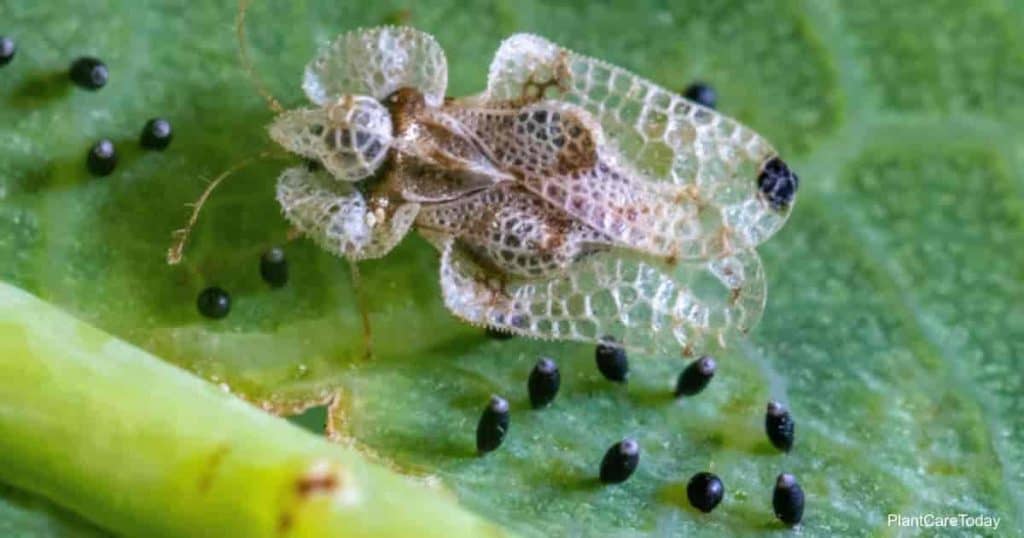One of the more destructive outdoor garden pests, lace bugs, has approximately 150 US species.
They get their name from the intricate veins on their wings and thorax and tend to be between ⅛” and ⅜” inches long.

Much like plant scale, lace bugs hide on the underside of leaves where they pierce the plant and drink its sap.
The result is dry, yellow patches on the leaf, possible leaves falling, and tiny black specks of fecal matter on the leaf surface.
Despite a lifespan of only 30 to 40 days, lace bugs go through as many as six nymph instars. They are active in summer and autumn, with some species overwintering their eggs.
Dealing with these pests can be difficult, and different species have different preferred host plants. Even worse, many species attack trees, which means many garden solutions are impractical.

But what about neem oil and what is Neem Oil?
Can this popular remedy – neem oil kill lace bugs, and how do you apply it?
How To Use Neem Oil For Controlling Lace Bugs
When dealing with large plants such as trees, a neem soil drench or soak works best, with extra spot foliar spray treatments where possible.
Smaller plants may use a combination of soil soak and spray to be extra-effective.
Does Neem Oil Kill Lace Bugs?
As with most piercing insect treatments, neem oil is an effective remedy that can kill lace bugs in one of several ways.
Foliar sprays act as contact killers, clogging the bug’s airway and causing it to suffocate.

When ingested, the primary active chemical in raw neem oil, Azadirachtin, is mistaken for the insect’s natural hormones. They stop eating, which interferes with their growth stages and interrupts or stops adult egg-laying.
More on How Neem Works To Kill Plant Pests
Azadirachtin can harm some beneficial insects when in contact with them. The foliar sprays use clarified neem oil, removing most of the Azadirachtin.
Clarified neem oil dissipates 45 minutes to an hour after application without leaving a residue. This makes it possible to avoid harming any beneficial or predator species if used during dusk or dawn.

The more Azadirachtin-rich raw neem oil used in soil soaks, the more it will get absorbed by the plant’s roots.
It becomes a systemic insecticide, so any bug that pierces the plant’s surface ingests it, but it remains harmless to insects that land on the plant.
Neem Oil is our FAVORITE natural organic insecticide. Control aphids, mealybugs, plant scale, Japanese Beetles and more. It can also be used as a soil drench.
How To Apply Neem Oil For Lace Bugs Via Soil Soak
When dealing with large plants, it’s best to go with a soil soak.
You can make your own at home using 100% percent cold-pressed raw neem oil.
- Make sure the oil is cold-pressed, as heat reduces the oil’s effectiveness.
- Emulsify some water (do this by adding 1 teaspoon of pure castile soap per gallon of water and blending), so the oil will mix.
- Add 2 tablespoons of raw neem oil per gallon of water and pour the mix over your infested plant’s roots. Use 2 to 4 cups for plants the size of rose bushes and more for larger plants.

The soil soak won’t harm earthworms but will travel up the plant to where the lace bugs will ingest it when they pierce the plant to drink.
A neem soak will last up to 22 days. Then reapply.
Using A Neem Foliar Spray On Smaller Plants
Smaller plants will enjoy a soil soak or a neem foliar spray.
You can buy a commercial spray or make your own using clarified hydrophobic neem oil.
This form of neem oil is processed to remove most of the Azadirachtin and is usually available in concentrations between .5% and 2% percent.

Choose the potency you wish to use and mix 4 teaspoons per gallon of emulsified water.
The spray needs to cover every surface of the infected plant. Use it as a spot treatment when paired with the soil soak.
Make sure to soak every lace bug nymph or adult you find.
Due to the quick dissipation rate, you will need to reapply the foliar spray every other day for 2 weeks.
After this period, continue treatments if there are survivors or choose to do an application every 14 days as a preventative measure.

